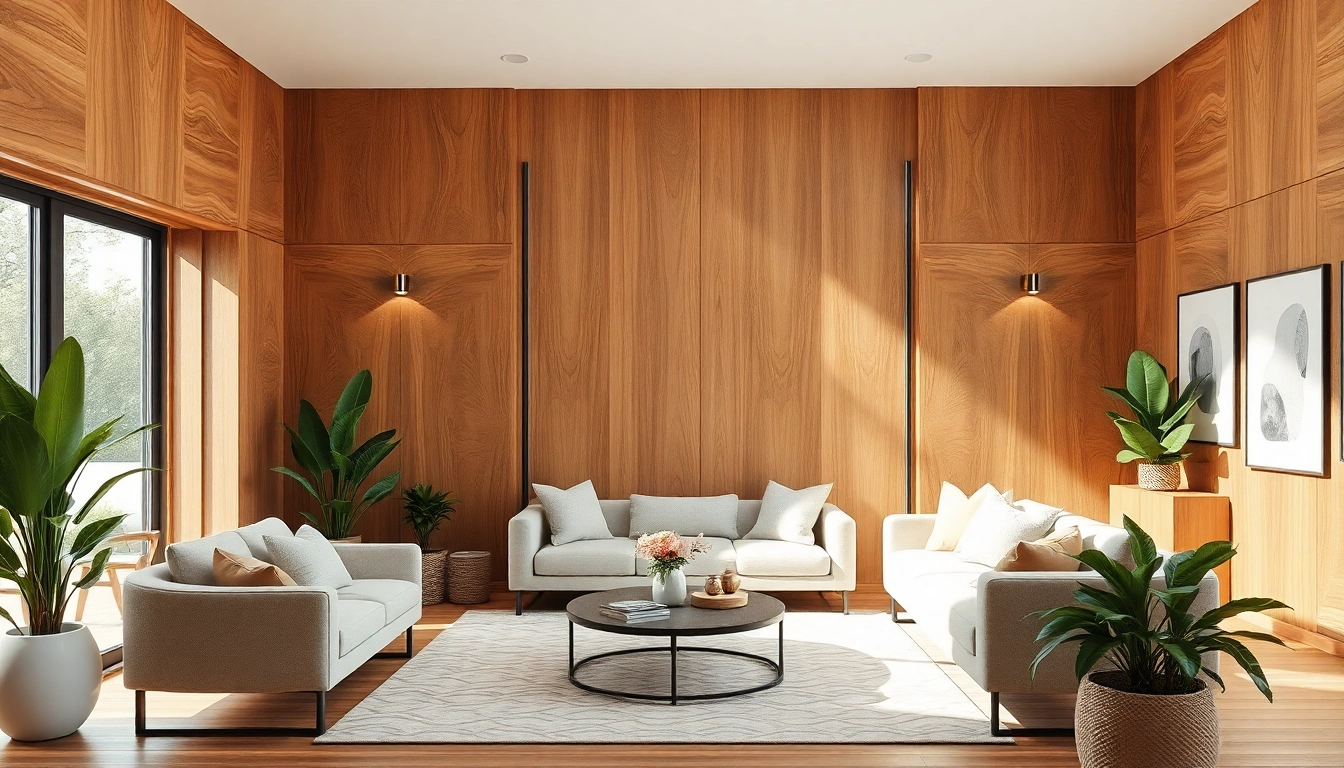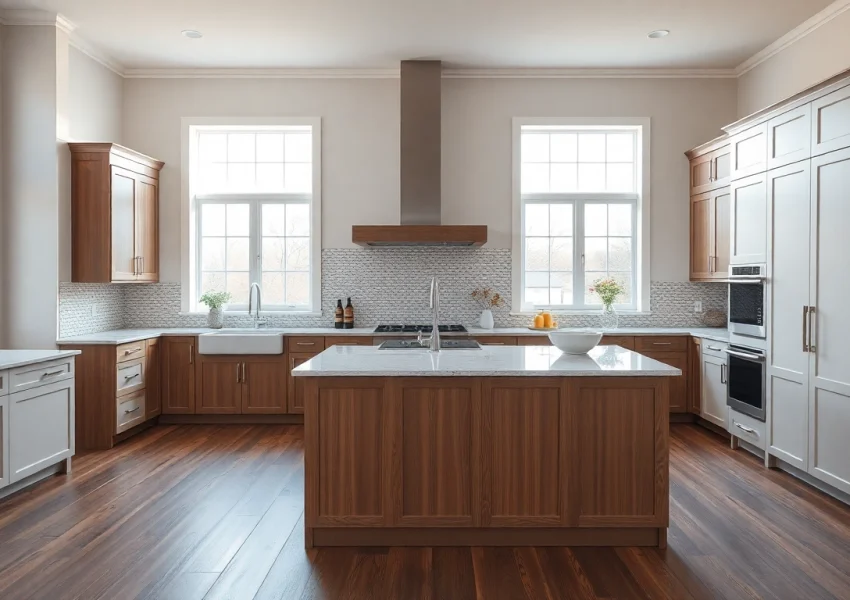Introduction to Wood Wall Paneling Ideas
Wood wall paneling is an increasingly popular choice for interior design, serving both aesthetic and functional purposes. Whether your aim is to introduce warmth, texture, or a touch of elegance to your spaces, utilizing wood wall paneling ideas can significantly enhance the overall atmosphere of your home. With the broad variety of styles, materials, and finishes available, wood wall paneling can transform a bland wall into an eye-catching element that reflects your personal style.
Understanding Wood Paneling Materials
Wood wall paneling can be crafted from various types of wood, each offering its unique texture, color, and grain patterns. Common materials include:
- Plywood: Affordable and versatile, plywood is made from thin layers of wood veneer glued together. It comes in various finishes and can be painted or stained.
- Hardwoods: Species like oak, cherry, and maple are popular for their durability and rich appearance. They often feature intricate grain patterns.
- Softwoods: Woods such as pine or cedar are lighter and easier to work with. They are often used in rustic designs.
- Reclaimed Wood: This eco-friendly option offers character and history, perfect for creating a unique feature wall.
Benefits of Wood Wall Paneling
Beyond aesthetics, wood wall paneling provides numerous benefits:
- Insulation: Wood acts as a natural insulator, helping to regulate temperature and reduce energy costs.
- Sound Dampening: Wood paneling can absorb sound, making spaces quieter and more enjoyable.
- Versatility: Suitable for any room, wood paneling can adapt to various design styles—from modern to rustic.
- Value Addition: Quality wood paneling can enhance the market value of your home due to its appeal and functionality.
Popular Styles of Wood Wall Paneling
As design trends evolve, so too do the styles of wood wall paneling. Here are some popular options:
- Shiplap: This classic style features overlapping boards that create a seamless look, perfect for a farmhouse aesthetic.
- Board and Batten: Alternating wide boards with narrow batten strips, this style adds depth and texture, ideal for entryways and living rooms.
- Tongue and Groove: Interlocking panels fit tightly together, providing a clean and polished finish that works well in contemporary spaces.
- Slat Wall Paneling: Featuring vertical or horizontal slats, this modern style is versatile and can create a dynamic feature wall.
- Wainscoting: Traditionally used in dining rooms or hallways, wainscoting provides a protective and decorative finish to lower wall areas.
Choosing the Right Wood for Your Wall Paneling Ideas
Types of Wood for Wall Paneling
Selecting the appropriate type of wood is crucial for achieving the desired aesthetic and functionality. High-density hardwoods are favored for their durability in high-traffic areas, while softer woods can be more suitable for decorative elements. Popular choices include:
- Oak: Known for its strength and beautiful grain, oak is perfect for traditional or contemporary styles.
- Pine: A cost-effective choice that is easy to work with, ideal for rustic or farmhouse themes.
- Cedar: Naturally resistant to moisture and pests, making it a good option for bathrooms and kitchens.
- MDF: Medium Density Fiberboard can mimic wood with a smooth finish; it’s often more economical and lightweight.
Sustainable Sourcing and Design
With the increasing emphasis on sustainability, many homeowners are opting for wood that has been sustainably sourced. This not only minimizes environmental impact but also supports responsible forestry practices. Consider looking for certifications like FSC (Forest Stewardship Council) which indicates that the wood was harvested in an environmentally conscious way.
Matching Wood with Room Aesthetics
When choosing wood for wall paneling, it’s important to match the wood with existing room aesthetics. Lighter woods can brighten smaller spaces, while darker woods can add depth and coziness, making large rooms feel more intimate. Neutral tones offer flexibility, allowing you to switch up décor easily throughout the year.
Creative Wood Wall Paneling Ideas for Each Room
Wood Paneling Ideas for Living Rooms
The living room is often the heart of a home, making the choice of wood paneling essential for creating a welcoming atmosphere. Here are some ideas:
- Accent Wall: Choose a bold, textured wood for one wall to create a focal point, complemented by lighter furniture and décor.
- Full Wall Paneling: Cover an entire wall with shiplap or tongue and groove to create a warm and inviting feel.
- Floating Shelves: Incorporate wood paneling with floating shelves to display decorative pieces or books, enhancing both style and functionality.
Bathroom and Kitchen Paneling Ideas
In kitchens and bathrooms, wood can add warmth and elegance while also being practical. Consider these options:
- Moisture-Resistant Treatments: Use sealed or treated wood in kitchens and bathrooms to withstand humidity and moisture.
- Half-Wall Wainscoting: In bathrooms, wainscoting can protect walls from splashes while providing a sophisticated look.
- Paneling as Backsplash: Use reclaimed wood for a rustic kitchen backsplash that adds character and complements modern appliances.
Bedroom Wood Wall Paneling Ideas
Wood wall paneling in bedrooms can create a serene and cozy atmosphere. Here are suggestions for incorporating wood into bedroom designs:
- Headboard Accent: Install wood paneling behind the bed as a striking headboard alternative, adding height and depth to the room.
- Cozy Cottage Style: Use warm-toned wood paired with soft textiles to create a comforting, cottage-like ambiance.
- Sustainable Decor: Consider using reclaimed wood for a unique feature wall that promotes sustainability.
Installation Techniques for Wood Wall Paneling Ideas
DIY vs. Professional Installation
While installing wood paneling can be a rewarding DIY project, it’s essential to assess your skill level and the complexity of the job. Here are key factors to consider:
- Experience Level: DIY installation can save money but may require a certain level of skill, especially with complex patterns like wainscoting.
- Time and Tools: Professional installers can complete the job faster, given their tools and expertise, while DIY projects may take longer.
- Cost Considerations: Weigh the cost savings of a DIY approach against the potential need to fix mistakes or hire help later.
Tools and Materials Needed
If you decide on a DIY installation, gather these essential tools and materials:
- Measuring Tape: To measure the wall space and wood accurately.
- Level: To ensure the panels are straight and evenly aligned.
- Stud Finder: Useful for locating the wall studs to secure the panels effectively.
- Power Drill: For fastening panels and securing brackets or screws.
- Wood Adhesive: Offers additional hold, especially for lightweight panels.
Step-by-Step Installation Guide
Here’s a simplified guide to installing wood wall paneling:
- Preparation: Clear the wall and ensure it’s clean and dry.
- Measure and Cut: Measure the wall space and cut the panels to the correct size. Always allow for expansion gaps.
- Attach Paneling: Begin attaching the panels from the base up or from one corner, ensuring they are level as you go.
- Finishing Touches: Once all panels are up, apply any desired finish, such as paint or stain, to enhance the wood’s natural beauty.
Maintenance and Care for Wood Wall Paneling Ideas
Cleaning and Upkeep Tips
To maintain your wood wall paneling, regularly dust and clean the surface. Use a damp cloth and mild cleaner to avoid damaging the wood. Avoid harsh chemicals that can strip the finish and negatively impact the wood’s appearance.
Long-Term Care and Preservation
To preserve the integrity of your wood paneling, consider periodic treatments with wood conditioner or sealants, particularly in areas prone to moisture.
When to Replace Your Wood Wall Panels
Signs that your wood wall panels may need replacement include warping, severe discoloration, or significant damage. If panels become warped or cracked, they can compromise the overall design and insulation properties of your walls.






